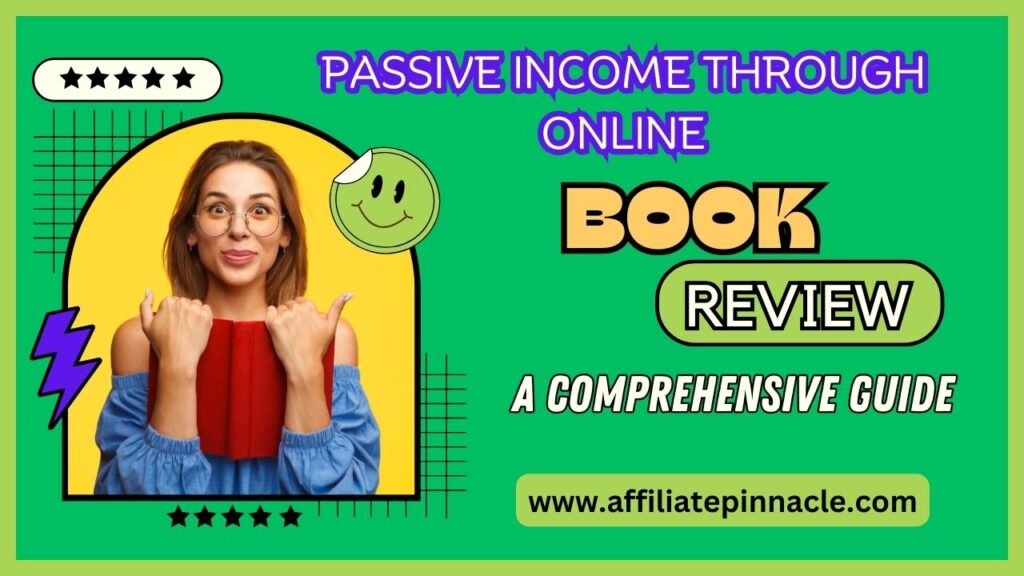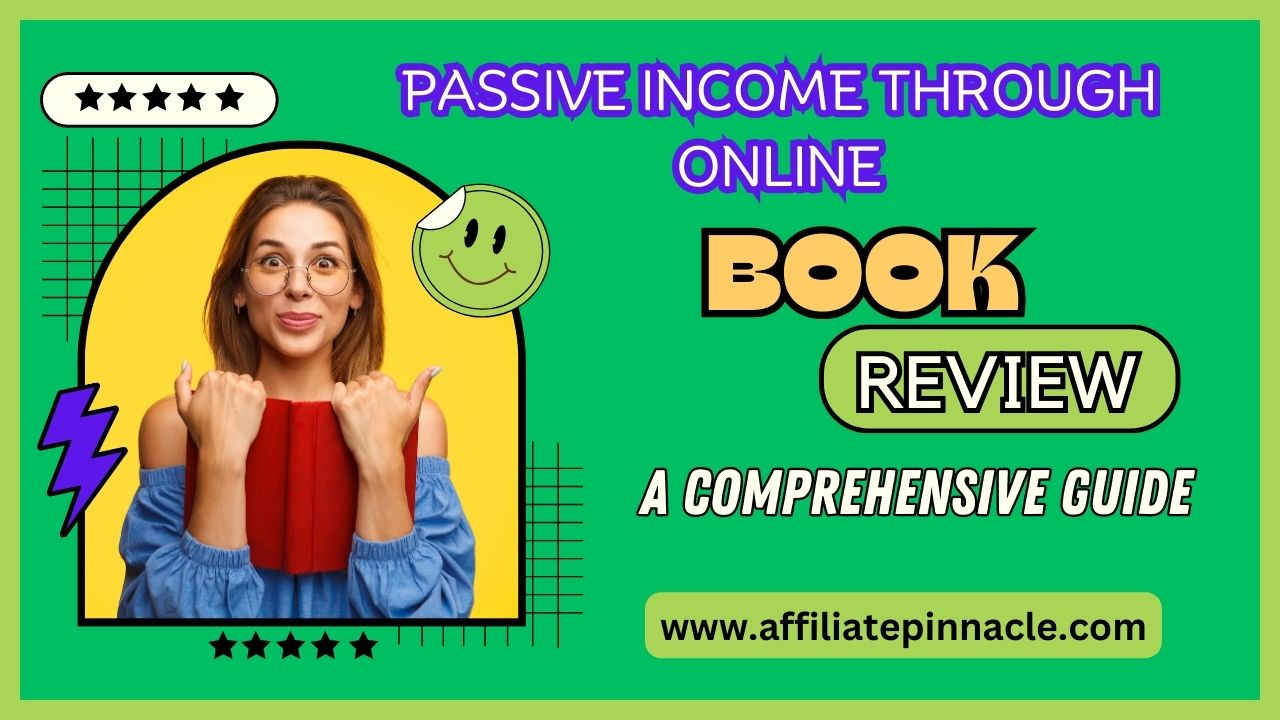In today’s digital age, the opportunity to generate passive income has expanded beyond traditional investments. One promising avenue for creating a steady stream of revenue is through online courses and e-books. As technology continues to shape the way we access and consume information, individuals with expertise in various fields can leverage their knowledge to build passive income streams. In this comprehensive guide, we will explore five key points to help you navigate the world of passive income through online courses and e-books.
“Cash Flow Explosion: Start Earning Big Bucks TODAY – Absolutely FREE Training!”
- Identify Your Niche and Target Audience: Before diving into the creation of online courses and e-books, it’s crucial to identify your niche and target audience. Select a subject you are passionate about and have expertise in. Conduct market research to understand the needs and preferences of your target audience. The more specific your niche, the better you can tailor your content to meet the demands of your audience.
- Create High-Quality Content: The success of your online courses and e-books hinges on the quality of your content. Invest time and effort in creating engaging, informative, and well-structured materials. Use a variety of media, such as videos, interactive quizzes, and downloadable resources for online courses. For e-books, ensure a polished and professional layout, complemented by insightful content. High-quality content not only attracts customers but also encourages positive reviews and word-of-mouth recommendations.
- Choose the Right Platform: Selecting the right platform is crucial for the success of your passive income venture. Numerous online platforms cater specifically to course creators and authors. Platforms like Udemy, Teachable, and Skillshare offer a user-friendly interface for hosting online courses. For e-books, consider publishing on popular platforms like Amazon Kindle Direct Publishing (KDP) or Smashwords. Assess the fee structures, user reach, and marketing tools provided by these platforms to determine the best fit for your content.
- Implement Effective Marketing Strategies: Even the most exceptional content won’t generate passive income if potential customers are unaware of it. Implement effective marketing strategies to promote your online courses and e-books. Leverage social media platforms, email marketing, and search engine optimization (SEO) techniques to increase visibility. Offering limited-time promotions, creating compelling landing pages, and collaborating with influencers in your niche can also boost your reach and attract a larger audience.
- Optimize for Passive Income: Once your courses and e-books are live, focus on optimizing for passive income. Consider creating subscription-based models for online courses, where learners pay a monthly fee for access to a library of content. For e-books, explore options like audiobook versions or bundle deals. Regularly update and expand your content to encourage repeat purchases and subscriptions. Additionally, invest time in building a strong community around your brand, fostering loyalty and word-of-mouth recommendations.
Conclusion:
Passive income through online courses and e-books offers an exciting opportunity for individuals to monetize their expertise. By identifying a niche, creating high-quality content, choosing the right platform, implementing effective marketing strategies, and optimizing for passive income, you can build a sustainable revenue stream while sharing your knowledge with a global audience. Embrace the digital landscape, and turn your passion into a lucrative endeavor that continues to generate income long after the initial effort.

Identify Your Niche and Target Audience
In the expansive world of online entrepreneurship, one of the critical foundations for success is the identification of a niche and a well-defined target audience. Navigating the digital landscape becomes significantly smoother when you understand your unique corner of the market and cater specifically to those who resonate with your content. In this article, we’ll delve into five essential points to guide you through the process of identifying your niche and honing in on your target audience.
“Cash Flow Explosion: Start Earning Big Bucks TODAY – Absolutely FREE Training!”
Follow Your Passion and Expertise:
- Start by identifying what you are truly passionate about and where your expertise lies. Consider your hobbies, professional experience, and the subjects that genuinely ignite your interest. When you’re enthusiastic and knowledgeable about a topic, your authenticity shines through in your content. This passion not only fuels your creativity but also attracts like-minded individuals who share your enthusiasm.
Conduct Thorough Market Research:
- Before finalizing your niche, conduct thorough market research to understand existing trends and gaps in the market. Analyze your potential competitors, identifying their strengths and weaknesses. This research helps you pinpoint opportunities where your unique perspective or additional value can be introduced. Investigate the demand for content in your chosen niche to ensure a viable audience awaits.
Define Your Unique Selling Proposition (USP):
- Clearly define what sets you apart from others in your chosen niche – your Unique Selling Proposition (USP). This could be a specialized skill, a distinctive approach to the topic, or a unique perspective that caters to an underserved audience. Your USP is what makes your content stand out and gives potential followers a compelling reason to choose you over others in the same space.
Understand Your Target Audience:
- Knowing your target audience goes beyond demographics. Dive deep into the psychographics of your potential audience – their values, preferences, challenges, and aspirations. Create detailed buyer personas to represent your ideal audience members. Understanding your audience on a personal level allows you to tailor your content to their specific needs, ensuring a more profound connection and increased engagement.
Test and Iterate:
- Identifying your niche and target audience is an ongoing process that may require some experimentation. Don’t be afraid to test different content approaches and evaluate audience responses. Use analytics tools to track engagement, gather feedback, and adapt your strategy accordingly. The digital landscape is dynamic, and the needs of your audience may evolve. Regularly revisit and refine your niche and target audience based on the insights you gather over time.
Conclusion:
Successfully identifying your niche and target audience is foundational to building a strong online presence and fostering a community around your content. By following your passion, conducting thorough market research, defining your Unique Selling Proposition, understanding your target audience, and continuously testing and iterating, you pave the way for a sustainable and engaging online venture. Embrace the journey of discovery, and watch as your authentic connection with your audience becomes the cornerstone of your digital success.
Create High-Quality Content
In the competitive landscape of online content creation, the adage “content is king” holds more truth than ever. The digital realm is flooded with information, making it imperative for content creators to rise above the noise by consistently delivering high-quality, valuable content. In this article, we’ll explore five crucial points to guide you in the art of creating content that captivates and resonates with your audience.
Understand Your Audience’s Needs:
- Before diving into content creation, invest time in understanding the needs and preferences of your target audience. Conduct surveys, engage in social media discussions, and analyze comments on your previous content to gain insights. By knowing what your audience is looking for, you can tailor your content to address their specific pain points, questions, and desires, ensuring it remains relevant and valuable.
Prioritize Clarity and Conciseness:
- High-quality content is not just about the depth of information but also about how effectively it is communicated. Prioritize clarity and conciseness in your writing or presentation style. Break down complex ideas into digestible segments, use straightforward language, and employ visuals or examples to enhance understanding. Your audience should be able to grasp the key takeaways without unnecessary complexity.
Invest in Visual Appeal:
- Visual elements play a crucial role in enhancing the overall quality of your content. Invest time and resources in creating visually appealing graphics, images, and multimedia elements. A well-designed and visually engaging piece of content not only captures attention but also reinforces the professionalism and credibility of your brand. Consider using tools or hiring a designer to elevate the aesthetic appeal of your content.
Maintain Consistency in Branding and Style:
- Consistency in branding and style is key to creating a cohesive and recognizable content identity. Define a consistent tone, color palette, and style guide for your content. Whether it’s blog posts, videos, or social media updates, maintaining a unified look and feel helps build brand recognition. Consistency also extends to the frequency and timing of your content releases, fostering anticipation among your audience.
Encourage Engagement and Interaction:
- High-quality content goes beyond providing information; it should stimulate engagement and interaction. Encourage your audience to share their thoughts, ask questions, and participate in discussions. Respond to comments and messages promptly, creating a sense of community around your content. Interactive elements such as polls, quizzes, and calls-to-action can further enhance engagement, turning passive consumers into active participants.
Conclusion:
Creating high-quality content is an ongoing commitment to excellence and audience satisfaction. By understanding your audience, prioritizing clarity, investing in visual appeal, maintaining consistency in branding and style, and encouraging engagement, you not only elevate the value of your content but also build a loyal and connected audience. In a digital landscape saturated with information, the quest for quality is what sets outstanding content creators apart, establishing them as trusted authorities in their respective niches.
Choose the Right Platform
Selecting the right platform for sharing your content is a pivotal decision in the world of digital creation. The diverse array of online platforms available today offers content creators an opportunity to showcase their work to a global audience. However, not all platforms are created equal, and choosing the right one can significantly impact the success of your content. In this article, we’ll explore five essential points to guide you in making an informed decision when it comes to selecting the platform that best aligns with your content and goals.
“Cash Flow Explosion: Start Earning Big Bucks TODAY – Absolutely FREE Training!”
Define Your Goals and Objectives:
- Before you decide on a platform, clearly define your goals and objectives. Are you looking to maximize reach, generate revenue, build a community, or establish authority in a specific niche? Different platforms cater to different objectives. For instance, if your primary goal is to sell courses, platforms like Udemy or Teachable might be suitable. If community-building is a priority, platforms like Patreon or Discord could be more aligned with your objectives.
Evaluate the Platform’s User Reach:
- The success of your content is closely tied to the number of eyes that see it. Evaluate the user reach of potential platforms by examining their user base, active engagement, and demographics. Choose a platform with a user demographic that aligns with your target audience. Platforms like YouTube and Instagram may offer broad audiences, while niche platforms like Behance or Dribbble cater specifically to creative professionals.
Consider Fee Structures and Revenue Models:
- Different platforms have varied fee structures and revenue-sharing models. Some platforms operate on a subscription-based model, while others take a percentage of your earnings per transaction. Evaluate the fee structures and revenue models of each platform to ensure they align with your financial goals. Factor in any upfront costs, transaction fees, or subscription fees associated with the platform before making a commitment.
Explore Marketing and Promotion Tools:
- The ability to effectively market and promote your content is crucial for success. Choose a platform that provides robust marketing and promotion tools. Features like analytics, email marketing integration, and promotional opportunities can significantly enhance your reach and impact. Platforms that support SEO optimization, social media sharing, and collaboration with other creators may contribute to the visibility and discoverability of your content.
Assess Community and Support Features:
- Building a community around your content can be a powerful driver of success. Assess the community and support features offered by each platform. Look for platforms that facilitate interaction among users, offer forums or discussion boards, and provide customer support. A strong community not only fosters audience loyalty but can also contribute valuable insights and feedback to improve your content.
Conclusion:
Choosing the right platform is a strategic decision that can shape the trajectory of your digital content journey. By defining your goals, evaluating user reach, considering fee structures, exploring marketing tools, and assessing community features, you empower yourself to make an informed choice. Remember that the ideal platform aligns not only with your content but also with your broader objectives, ensuring a symbiotic relationship that propels your content to new heights in the vast and dynamic digital landscape.
Implement Effective Marketing Strategies
In the crowded digital sphere, creating exceptional content is just the beginning of a content creator’s journey. To truly succeed, one must master the art of effective marketing. Implementing robust marketing strategies is crucial for increasing visibility, attracting a larger audience, and ultimately maximizing the impact of your content. In this article, we’ll explore five key points to guide you in implementing effective marketing strategies for your digital creations.
Leverage the Power of Social Media:
- Social media platforms are dynamic hubs of activity, providing an excellent avenue to promote your content. Identify the platforms that resonate most with your target audience and create a consistent presence. Share snippets, behind-the-scenes content, and engage with your audience through comments and messages. Utilize features like Instagram Stories, Twitter polls, and Facebook groups to foster a sense of community around your content.
Invest in Influencer Collaborations:
- Collaborating with influencers in your niche can exponentially increase the reach of your content. Identify influencers whose audience aligns with yours and reach out for collaborations. This can involve co-creating content, shoutouts, or guest appearances. Influencers already have a dedicated following, and their endorsement can introduce your content to a broader audience that is predisposed to engage with your material.
Optimize for Search Engines (SEO):
- Enhance the discoverability of your content by optimizing it for search engines. Conduct keyword research to identify terms relevant to your content, and strategically incorporate them into your titles, descriptions, and tags. Create SEO-friendly blog posts, video descriptions, or podcast transcripts. By aligning your content with popular search queries, you increase the likelihood of attracting organic traffic and expanding your audience.
Implement Email Marketing Strategies:
- Email marketing remains a powerful tool for nurturing a loyal audience and driving engagement. Encourage your audience to subscribe to newsletters or mailing lists. Regularly send updates, exclusive content, and personalized messages to keep your audience engaged. Email marketing is not only a direct communication channel but also an effective way to promote new releases, products, or special offers to your most dedicated followers.
Utilize Paid Advertising Wisely:
- While organic methods are essential, consider incorporating paid advertising into your marketing strategy. Platforms like Google Ads, Facebook Ads, and Instagram Ads allow you to target specific demographics and interests. Allocate a budget for targeted campaigns to reach a wider audience. Monitor the performance of your ads, analyze metrics, and adjust your strategy based on what resonates most with your audience.
Conclusion:
Implementing effective marketing strategies is the linchpin of success in the digital content landscape. By leveraging social media, collaborating with influencers, optimizing for search engines, implementing email marketing, and utilizing paid advertising, you can maximize the visibility of your content. Remember that an integrated and thoughtful approach to marketing not only attracts new audiences but also fosters lasting connections with your existing community, solidifying your position as a content creator to be reckoned with.
Optimize for Passive Income
Passive income, derived from the fruits of your initial efforts, is a financial goal that many aspire to achieve. For content creators venturing into the realms of online courses, e-books, and digital products, optimizing for passive income is a crucial step toward creating a sustainable revenue stream. In this article, we’ll explore five key points to guide you in maximizing your passive income potential.
“Cash Flow Explosion: Start Earning Big Bucks TODAY – Absolutely FREE Training!”
Explore Subscription-Based Models:
- Consider adopting subscription-based models for your online courses or exclusive content. Platforms like Patreon or Substack allow creators to offer premium, subscription-based access to their work. This provides a steady and predictable income stream as your audience commits to regular payments in exchange for ongoing access to your latest content. Subscriptions can create a sense of community and loyalty among your audience, fostering long-term relationships.
Diversify Your Product Offering:
- Expand your passive income potential by diversifying your product offering. Instead of relying solely on one-time purchases, consider creating supplementary materials, advanced courses, or exclusive content bundles. By providing a range of products at different price points, you cater to a broader audience and encourage repeat purchases from those who have already enjoyed your initial offerings.
Embrace Affiliate Marketing:
- Affiliate marketing can be a powerful tool to boost your passive income. Identify products or services that complement your content and align with your audience’s interests. Promote these affiliate products through your courses, e-books, or content platforms, and earn a commission for each sale generated through your unique affiliate links. Be transparent with your audience about affiliate partnerships to maintain trust.
Regularly Update and Expand Content:
- Passive income doesn’t mean static income. To keep your offerings relevant and enticing, regularly update and expand your content. For online courses, this could involve adding new modules or updating existing ones to reflect industry changes. With e-books, consider releasing updated editions or creating companion guides. By staying current, you encourage repeat purchases and subscriptions while attracting new customers.
Build a Strong Community:
- A loyal and engaged community can be a driving force behind sustained passive income. Foster a sense of belonging among your audience by creating discussion forums, hosting webinars, and encouraging interaction. A strong community not only boosts your content’s visibility but also increases the likelihood of word-of-mouth recommendations, bringing in new customers without active marketing efforts.
Conclusion:
Optimizing for passive income is a dynamic process that requires strategic planning and continuous effort. By exploring subscription-based models, diversifying your product offering, embracing affiliate marketing, regularly updating content, and building a strong community, you create a robust foundation for a sustainable and growing stream of passive income. Remember, the key lies not only in creating great content but in strategically managing and expanding your offerings to meet the evolving needs of your audience over time.
“Cash Flow Explosion: Start Earning Big Bucks TODAY – Absolutely FREE Training!”
I appreciate you reading my full article, Passive Income through Online Courses and E-books: A Comprehensive Guide



